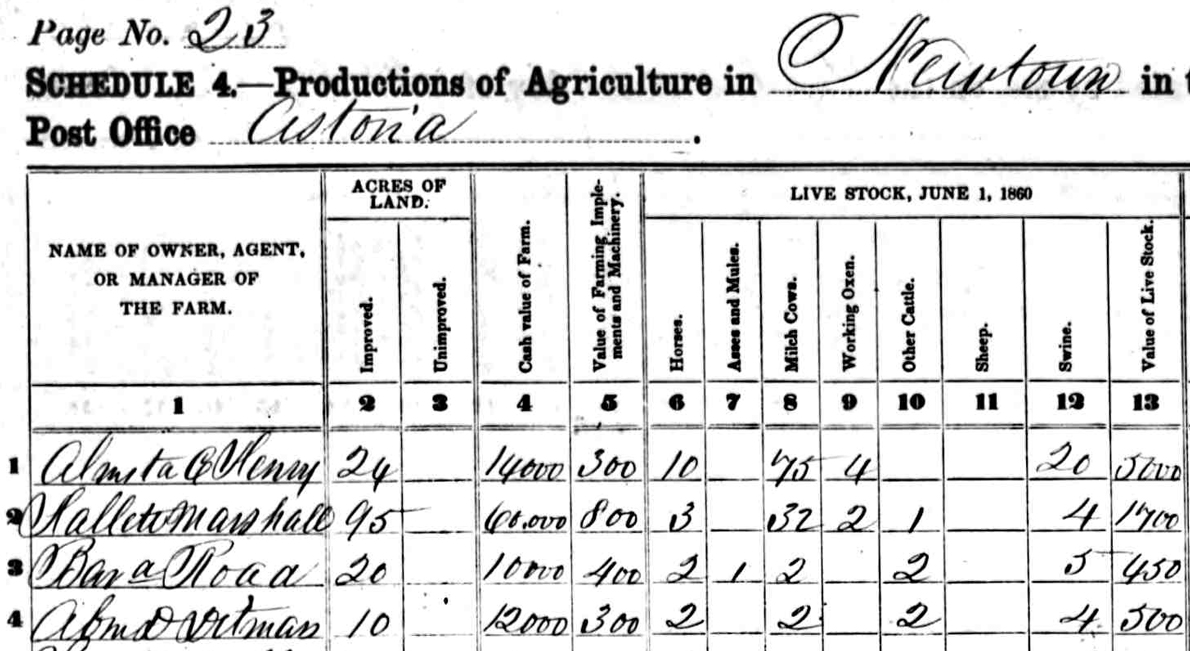Bernard Rottkamp Farming History
Ed Wesnofske
March 2011
Ed Wesnofske
March 2011
Part 1
Newtown (Astoria Post Office in 1860)
When Bernard Rottkamp and his new wife Caroline decided to have Bernard leave his job as a factory worker in New York and embark on a farming enterprise in the mid-1850's, a few years after their marriage, they could have little idea of what the future held for them and their children.
For the young couple it may have seemed like it would be the move of a lifetime – but as it turned out, it would be a temporary transition for a few years until a decisive and permanent move into Foster’s Meadow in 1861. His initial purchase of a farm of 20 acres in Newtown had been achieved primarily on savings from working by the mid 1850's. When it was to be sold at the time of the outbreak of the Civil War, it would be valued at a hefty price of about $500 an acre.
Bernard’s purchase of that farm in Newtown Township of Queens County in the 1850's turned out to be a boon. The growing population of New York County opposite Queens on the East River began to spill over at that time in a growing wave of new immigrants, many of whom had earned the resources by 1855 to expand their horizons and settle in Queens. And for a farmer, the market across the river in New York County was ripened by the newly expanded ferry systems.
The farm was located south of the hamlet settlement of Newtown (today's Elmhurst) along the area of Hoffman Boulevard (today's Queens Boulevard) at about the intersection of today's 57th Avenue. His nearby farming neighbors in the 1860 Census were the two Vandeveers, Engle (not related to Caroline), Backus, Remsen, Uhl and Kouwehoven.
The appreciated value of Newtown farm land sold in 1861 under the pressure of development was invested in the purchase of a more permanent homestead and farm property on Foster’s Meadow Road on the border of Jamaica and Hempstead Townships in Queens. This was before the consolidation New York Brooklyn, Long Island City, and suburbs into Greater New York City in 1898.
The hard work and the labor supply from the large family that followed would allow acquisition of even more land for farming in the Foster’s Meadow area and its passage to the next generation of farmers of the Rottkamp clan.
Bernard prospered on his original farm in Newtown. By the time he was moving to Foster’s Meadow, he had 4 cows, 2 for milk and 2 for beef. Along with that he had a mule on his 20 acres, a team of 2 horses to pull his market wagon (and probably the vehicle of church and travel to the Astoria village). Oxen remained part of some traditional draught sources on farms in the area but Bernard had none.
| 1860 U.S. Census
of Agriculture Line 3: Bar d Road is Bernard Rottkamp |
 |
Other Names above w/abbreviations: (1)Olmstead C. Henry, (2)Rallett Marshall, (4)Abraham D. Detman.
 Henry Wulforst is #25 on the same page; almost twice the farm acreage and four times estimated value of the farm.
|
NOTE: The misrecording and misspelling of 'Rottkamp' is common in the historical and newspaper records. There is no doubt that this Bernard because the discovery of the 1860 household census lists the family members then living for the Bar'd Road family, daughter Sarah who was to die in 1872. |
Click here for 1860 Rottkamp Household Census |
Along with this livestock were 5 pigs. Altogether, the livestock would be worth about $450. During these years some of the beef cows and swine would be slaughtered for family consumption and sale to the market. This would provide an income of about $40 from animal product.
Besides livestock, Bernard had vegetables and grain production. A major item was beans and peas to the extent of about 300 bushels produced. Potatoes were a slightly smaller crop of about 100 bushels off the farm. The potato production probably was used mainly for family consumption. A century later, potato crop yields of 400 bushels per acre on farms of 200 or more acres could be found on Long Island – with the help of better soils, fertilizer, pest control and mechanization of production.
Grain production was important for animal feed and household baking and food needs. On Bernard’s farm in Newtown, his significant crop was “Indian corn” for animal feed to the tune of 200 bushels per year.
Besides the corn, the farm produced about 50 bushels of oats, 40 bushels of wheat, and 30 bushels of rye plus 10 tons of hay per year.
Milk from the 2 cows was churned into about 200 lbs. of butter, some for domestic use and the rest sold.
His income from farming at the time was about $1,500.
©2011 Edward R. Wesnofske P.O. Box 3029, Bridgehampton, NY 11932
Email: edwesnofske@optimum.net